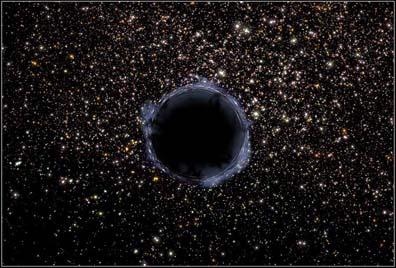According to a recent study, black holes are giant fuzzballs. The study tries to end the debate over Stephen Hawking’s well-known information paradox - the problem created by Hawking’s conclusion that any data that enters a black hole cannot leave.
 A new study confirms answers to Stephen Hawking’s black hole information paradox. Image Credit: Ohio State University.
A new study confirms answers to Stephen Hawking’s black hole information paradox. Image Credit: Ohio State University.
This conclusion was in agreement with the laws of thermodynamics but was against the fundamental laws of quantum mechanics.
What we found from string theory is that all the mass of a black hole is not getting sucked into the center. The black hole tries to squeeze things to a point, but then the particles get stretched into these strings, and the strings start to stretch and expand and it becomes this fuzzball that expands to fill up the entirety of the black hole.
Samir Mathur, Study Lead Author and Professor, Physics, The Ohio State University
The study was reported in the Turkish Journal of Physics on December 28th, 2021. It discovered that string theory has the answer to Hawking’s paradox almost certainly, as the paper’s authors had believed originally. The physicists demonstrated theorems to prove that the fuzzball theory remains the probable solution for Hawking’s information paradox.
Furthermore, the researchers have reported an essay displaying how this work might resolve long-term puzzles in cosmology, and it appeared in the International Journal of Modern Physics in December 2021.
In 2004, Mathur reported a study that theorized that black holes resemble very big and very messy balls of yarn — “fuzzballs” — that get larger and messier as new objects are sucked in.
The bigger the black hole, the more energy that goes in, and the bigger the fuzzball becomes.
Samir Mathur, Study Lead Author and Professor, Physics, The Ohio State University
The 2004 study discovered that string theory (the physics theory) that states that all particles in the universe are built of small vibrating strings can be the solution to Hawking’s paradox. Having this fuzzball structure, the hole radiates as any normal body, without any puzzle.
After his 2004 study and other such works, Mathur stated, “Many people thought the problem was solved. But in fact, a section of people in the string theory community itself thought they would look for a different solution to Hawking’s information paradox. They were bothered that, in physical terms, the whole structure of the black hole had changed.”
Over the past few years, studies attempted to settle Hawking’s conclusions with the old picture of the hole, where the black hole seems like an “empty space with all its mass in the center.”
The wormhole paradigm theory indicated that black holes may be one end of a bridge in the space-time continuum, implying anything that entered a black hole may show up at another end of the bridge (or the other end of the wormhole) in a different place in time and space.
For the wormhole picture to work, few low-energy radiations would have to escape from the black hole at its edges.
This latest study proved the “effective small corrections theorem” to display that if that were to happen, black holes would not show up to radiate in the method that they do.
Furthermore, the scientists analyzed physical properties from black holes, such as topology variation in quantum gravity, to identify if the wormhole paradigm would work.
In each of the versions that have been proposed for the wormhole approach, we found that the physics was not consistent. The wormhole paradigm tries to argue that, in some way, you could still think of the black hole as being effectively empty with all the mass in the center. And the theorems we prove show that such a picture of the hole is not a possibility.
Samir Mathur, Study Lead Author and Professor, Physics, The Ohio State University
The other scientists from Ohio State who worked on this study include Madhur Mehta, Marcel R. R. Hughes, and Bin Guo.
Journal Reference:
Guo, B., et al. (2021) Contrasting the fuzzball and wormhole paradigms for black hole. Turkish Journal of Physics. https://doi.org/10.48550/arXiv.2111.05295